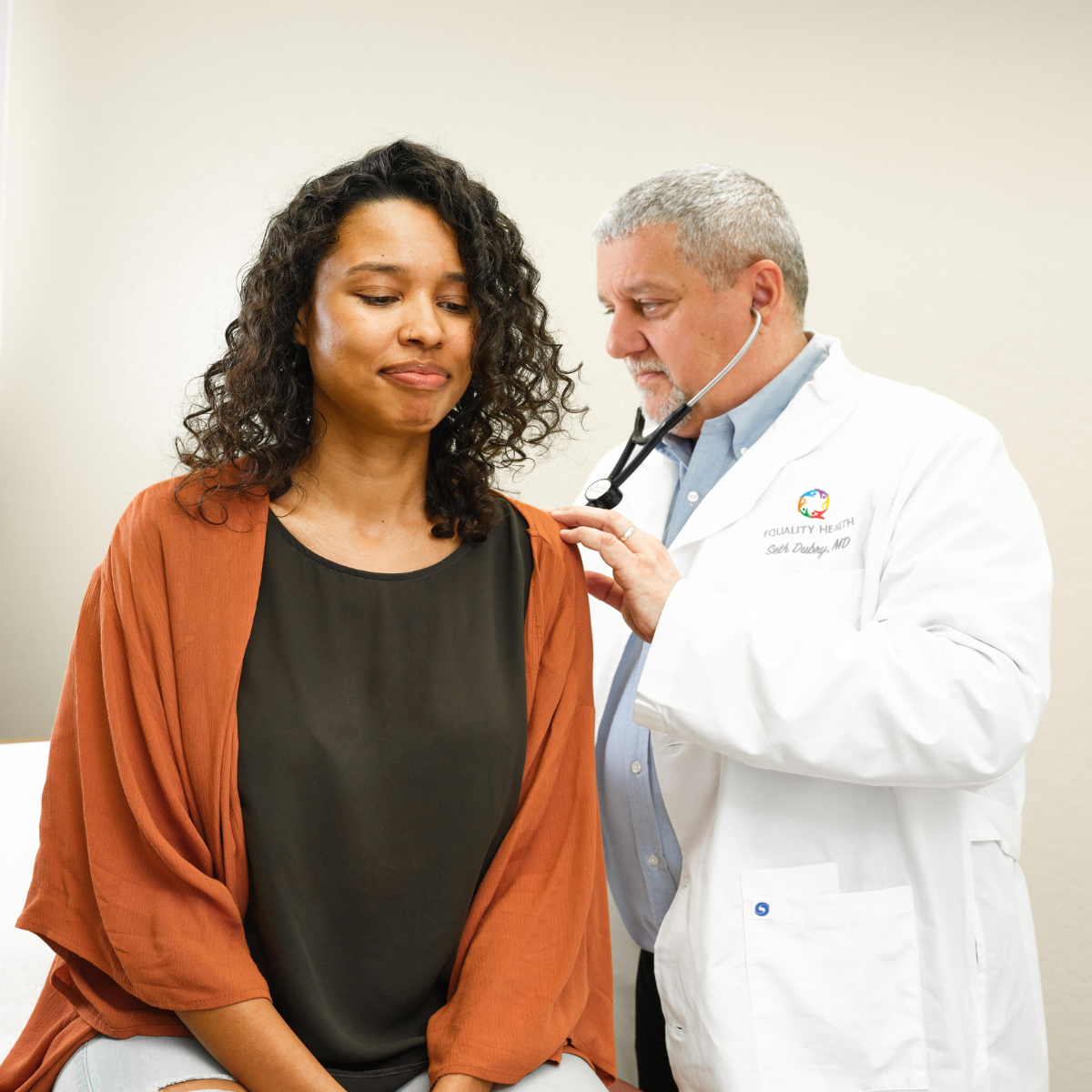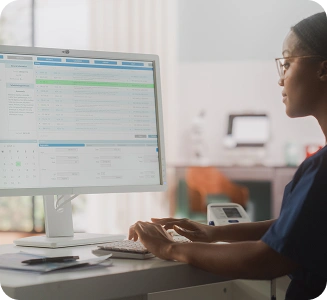How COVID-19 and Telehealth Transformed Care Delivery for an Arizona Physician Practice
By Equality Health
Now that virtually everything during the COVID-19 pandemic has gone virtual, why not a trip to the doctor too? Equality Health® has added telemedicine to the list of its defining features available to primary care providers to enhance their patients’ well-being.
Telemedicine goes back to the late 1950s when the University of Nebraska used it to transmit neurological examinations. The National Aeronautics and Space Administration got involved with it in the 1960s with the Space Technology Applied to Rural Papago Advanced Health Care project for Native Americans on Arizona’s Tohono O’odham Nation. The system took a giant leap forward when it was connected to the internet in the 1990s, but state and federal policies slowed its common use — until the COVID-19 pandemic came along.
“When the pandemic started, we were at once confronted with multiple concerns,” Dr. Rodd Aking, Trinity Integrated Medicine’s physician owner recalled. “The health and safety of families and patients first, but also about our practice and how we were going to adjust to deliver care under these new circumstances. It was a troubling and overwhelming time, especially given the limited resources of our small practice. That’s when the Equality Health team stepped in and we continue to receive support from them.”
When Medicine Meets IT
One of the first physician practices within Equality Health’s network of providers to implement this virtual care solution, Trinity Integrated Medicine, found this once-futuristic feature to be an invaluable tool for present-day care. Their patients comprise a vulnerable population with multiple medical conditions that require ongoing care.
“When we saw what was happening and the rapidity at which the pandemic was developing,” Dr. Aking explained, “we knew what was coming. We just realized that telemedicine was the only option. Actually, it wasn’t just an option. It was the only and obvious option.”
In order to continue caring for patients, Dr. Aking realized the practice had to move fast. He called Equality Health’s Chief Medical Officer, Mark Stephan, M.D., to get his input.
“Dr. Stephan said that he wanted us to be the guinea pig,” Dr. Aking said with a chuckle. “But seriously, he made it happen. Almost overnight a team from Equality Health was sent to our office to set up a telemedicine platform. We were also given training as well as documentation and billing resources to help us navigate the process. I’m really grateful for that.”
In fact, Equality Health’s Practice Performance Managers (PPMs) Lisa Morey and Tammy Baron were immediately on the scene to help launch Dr. Aking’s telehealth program . “We were there for about two-and-half hours,” explained Lisa Morey, Manager of Provider Network Services at Equality Health. “We walked them through various telehealth scenarios on different devices so that they were fully prepared to handle any and all obstacles that they may encounter. We taught them how to activate an account through email, how to start and join a telehealth meeting, how to admit a patient into the waiting room, for example, and we reviewed all the documents in the telehealth toolkit.”
The Equality Health team advised Dr. Aking to practice what he learned with his staff over the weekend and even offered their assistance anytime, day or night and even on the weekend, if needed.
But the cure did not come without a bit of pain. “The obvious barrier was the technology,” Dr. Aking said, “especially with the types of patients that we take care of — older Medicare-type patients and patients with serious mental illness. We have a large AHCCCS population. So it was sometimes the unfamiliarity with technology that was the roadblock.”
“What was kind of surprising also,” Dr. Aking continued, “was how people really didn’t know why we were doing it. We assumed everyone was up-to-date with the COVID-19 pandemic that was brewing, and we realized many people were not. So we had to start from there to explain why we were doing it, why it was important, and why this would probably be the only option we had in the near term to deliver their care. So when people learned why we were doing it and why it was important, then they started to listen more closely.”
All Hands on Deck
Next, the practice staff had to become tech savvy. This took several meetings to familiarize everyone with the technology. They had to better acquaint themselves with the virtual care solution, learn the app’s different functions and educate themselves so that they were able to make the technology work – for themselves and their patients.
“We made sure our patients were able to download the app,” explained Office Manager, Erika Quintana, “knew how to use it, and weren’t lost to where they didn’t even want to join the visit because they didn’t know what to do next. We were able to follow through with them to make sure they were going to be able to hear and see and not leave them there by themselves.”
Dr. Aking’s staff learned enough about the app to be able to educate their patients, and they made sure their patients had everything they needed from the beginning of the call until they got connected with the provider. This required some coaching to keep patients from getting lost or feeling abandoned because they didn’t know what to do next.
“They were learning IT stuff,” Dr. Aking summed up the scene. “They prepared by trying to school themselves in IT. People often say that, you know, ‘I’ve done this,’ or whatever. It was, honestly, the whole staff buying into this idea, this mission of what we’re doing. I had absolutely nothing to do with it. I myself am not the most tech-savvy person. So they kind of trained me too.”
Trinity Integrated Medicine Goes Live
The training worked. At this point, Trinity Integrated Medicine almost exclusively sees their patients virtually.
“Because you know,” Dr. Aking explained, “people are really fearful. They do not want to come into the doctor’s office, right? And also, we don’t really have protective gear for when we see patients. So it’s almost exclusively telemedicine. I think when Governor Ducey declared his executive order about telephone medicine, then that became really, really important for older folks.”
Dr. Aking shared that the practice also uses video-conferencing “big time” for behavioral health and commented that their psychiatric patients seem to do better with it due to the unique form of interaction. Clinically, video-conferencing makes sense for patients that have challenging mental health disorders to be able to visually see their affect, which is important in assessing how they’re progressing.
“And not only that,” Dr. Aking added, “but we’re also going to start the Collaborative Care Model, the CoCM.”
The Collaborative Care Model uses a team-based, interdisciplinary approach to deliver evidence-based diagnoses, treatment and follow-up care to an identified patient population. The care manager, if a licensed mental health professional, may provide some short-term therapy in some cases.
“So we are using this as a first step in that direction because I think that’s very important now,” Dr. Aking said. “So you have Equality Health Care Management and then you have the CoCM for mental health. I think it’s a really good opportunity for practices to start implementing that now.”
“With a lot of the patients,” Dr. Aking continued, “especially older people, it’s still more comfortable to use the telephone. It’s more natural than using the video-conferencing. It’s very awkward for them. So the whole idea that we can use the telephone encounters has really helped us. We’ve maintained the video-conferencing for the psychiatrist, who still kind of prefers that. But for our older folks, more or less, we’re doing telephone consults now.”
Beyond COVID-19
Equality Health asked Dr. Aking to share some of the best practices that he and his staff learned when transitioning to telemedicine.
“Explain to the patient why you’re doing this crazy thing,” Dr. Aking said. “Don’t assume they know, and don’t assume they really appreciate why you’re doing it. So, education and communication. Of course, the staff definitely has to buy in. They’re going to make it happen. We can’t employ an IT team to educate the patients. Everyone has to do this. It’s basically a new skill set.”
Once the staff learns the app, the operating systems, and the phones, they need to anticipate the reactions from the patients. And they need to do so with the utmost understanding and compassion.
“You have to be willing to be patient with the patients,” Dr. Aking said, “to let them learn how to do it because they give up really, really quickly. And they make all sorts of excuses and the staff always have an answer.”
Like?
“‘I don’t have a phone,’” Dr. Aking gave an example. “So the staff will say, ‘Well, which phone are you using right now?’ Then, ‘I’ll go and ask my friend.’ Well, can your friend lend you the phone? Can your friend help you download the app?
“Don’t give up would be a big do — or don’t,” Dr. Aking continued. “Don’t give up. We don’t have any other way to communicate with the patients right now. Not seeing them is not an option, so you’ve got to make this thing happen.”
It took COVID-19 to catalyze this change in delivering healthcare virtually, expanding telemedicine‘s utilization. It has potential to be a long-term solution for delivering healthcare going forward. Practices like Trinity Integrated Medicine that are incorporating it now will be in a ready position to continue to evolve and sustain themself in healthcare’s evolving value-based risk-based environment.
“I hope they don’t put the genie back into the bottle,” Dr. Aking quipped. “For us, telemedicine is here to stay.”




